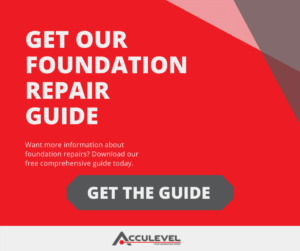Floating Slab vs Monolithic Slab: Key Differences & Strength – Which Is Best?

If you don’t have a basement or a crawl space under your house, you have a concrete slab foundation. This is common knowledge, right? But did you know that there are different types of slab foundations?
In fact, I think most homeowners assume the same thing I did – that every slab foundation is built the same way, but in reality, there are different construction methods, each designed with specific reinforcement, load-bearing capacity, and moisture resistance in mind.
The most common comparisons include:
- Floating slab vs monolithic slab – How do these foundation types differ in installation, durability, and stability?
- Monolithic slab vs traditional slab – Which offers better support, especially in areas with soil movement and frost concerns?
Acculevel is a family-owned and operated company specializing in foundation repair, waterproofing solutions, and structural stabilization. Founded by Andy Beery, we are a growing regional company with small-town values, proudly serving all of Indiana and portions of the surrounding states. Since we started in 1996, we have helped more than 35,000 homeowners restore the stability, strength, and durability to their homes.
In this article, we’ll break down the three main types of slab foundations, including a detailed look at floating slab foundations. We’ll explain how each foundation type is constructed, why proper reinforcement is crucial, and how to prevent cracking, settling, and moisture damage.
Types of Floating Slab Foundations
A floating slab is a single layer of concrete poured directly onto leveled soil, while a monolithic slab has built-in footings that extend deeper for added stability. Floating slabs are often used for garages, sheds, and additions where traditional foundations aren’t necessary.
If your home has a floating slab foundation or another type of concrete foundation, understanding how it reacts to soil movement, moisture, and load distribution can help you make informed maintenance decisions and prevent future foundation issues.
Monolithic Slab vs Traditional Slab Foundations
The main difference between monolithic slab vs traditional slab foundations is that a monolithic slab is a quicker and more efficient way to pour a concrete foundation. Instead of three separate sections to pour, the foundation walls and slab are combined and poured at one time, and the footings do not need to be dug as deep as with the traditional method. This makes monolithic slabs a cost-effective option for certain structures.
This traditional slab foundation is the most common type, often used in homes with basements. A footing (or footer) is a reinforced concrete base that supports the structure and helps distribute the load evenly. This footing is only poured around the perimeter, providing stability while allowing the slab to rest on compacted soil.
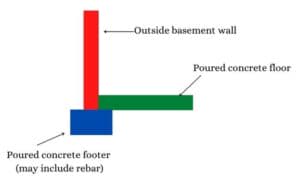
Rough sketch of a slab foundation with footer (Created by the author).
If you look at the sketch we provided, you’ll notice a gap under the poured concrete floor. This gap is usually filled with compacted material to create a level surface and provide support when pouring the slab.
However, if this fill layer is not properly compacted or becomes eroded, it can lead to an empty void beneath the foundation. Over time, this weakens the supporting soil, causing the slab foundation to crack under pressure from the structure’s weight.
How Do You Fix A Cracked Slab Foundation with Traditional Footings?
The best way to repair a cracked slab foundation with traditional footings is through concrete leveling repair like slabjacking. This process involves injecting a specialized fill material beneath the slab foundation to stabilize the structure.
As the material expands and fills voids, it gradually lifts the foundation back to its original position, restoring its load-bearing capacity. Once the slab is leveled, the crack can be filled and smoothed, reinforcing the foundation’s strength and preventing further structural damage.
Traditional Footings Can Also Be Damaged By Erosion
If water erodes the ground under one of your footers, it can weaken the soil beneath a foundation, leading to uneven settling. If a footer is affected, it may begin to sink, causing stress across the concrete slab.
The most common signs of foundation settling include drywall cracks, especially near doors and windows, as well as floors that slope or crack. In some cases, doors and windows may stick or become difficult to open, signaling structural strain.
If left unaddressed, erosion-related settling can lead to major foundation issues, compromising the stability and strength of the structure. Identifying these warning signs early can help prevent costly repairs.
You Need Piers to Repair A Settling Slab Foundation
Helical piers are the best way to stabilize a setting foundation. These long steel posts are screwed deep into the ground next to your foundation footings until they reach stable soil (measured using a pressure gauge). Once in place, they are secured to the footer, preventing further foundation movement.
In some cases, piers can lift the footer back to its original position, but results vary depending on how long the foundation has been settling and the extent of the structural shift.
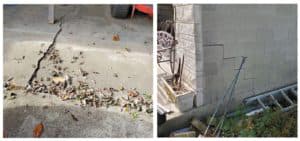
Images of a settling slab foundation
These photos, taken during an Acculevel in-home assessment, show a front corner footing that has settled several inches, resulting in cracking along the wall and floor.
When a footer settles, it can cause stress fractures in the slab, as the foundation shifts unevenly. This movement may result from soil erosion, moisture issues, or poor compaction during the initial foundation installation. In most cases, the best repair method is a combination of helical piers for stabilization and slabjacking to restore slab alignment and strength.
What Is a Floating Slab Foundation?
A floating slab foundation is a concrete foundation that sits directly on flat, level soil, allowing it to “float” without deep footings. Since it relies on soil support rather than structural reinforcement, floating slabs are typically used for garages, sheds, and small additions, rather than full homes.
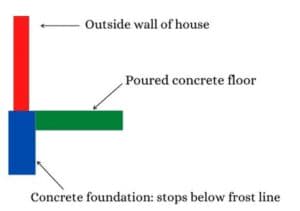
This is a rough sketch of a floating slab (done by the author).
Unlike traditional foundations, a floating slab includes a concrete footer, but the exterior walls are built directly on top of the footer. The slab floor is poured afterward, meaning it rests on the footing rather than supporting the entire structure.
Although floating slabs offer cost-effective construction, they are still vulnerable to erosion. If soil shifts beneath the slab, it can create voids, leading to foundation cracks. But, because the floor is separate from the footer, the settling footer does not apply as much pressure to the slab as it would in a traditional foundation.
In cases where erosion occurs under the slab itself, slabjacking may be necessary to restore stability. This process injects fill material beneath the slab to lift and support it, preventing further cracking and structural damage.
A Monolithic Slab Foundation
A monolithic slab foundation is the least common type of concrete foundation. (It’s rare, but we have seen a few basements with this slab type, also). Unlike floating slabs or traditional footings, a monolithic slab is poured as one continuous piece, with both the concrete footing and floor formed simultaneously.
The entire surface of the building site has to be tamped down and fully prepared, all at once. This is because a monolithic foundation is all one piece; the concrete footing and floor are poured together.
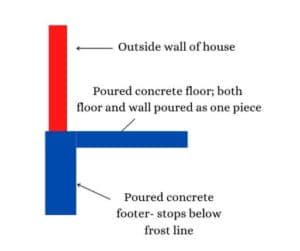
Rough sketch of a monolithic slab (Done by the author).
Erosion is a threat to monolithic slabs. Because the floor and footers are a single unit, any settling or shifting affects the entire foundation structure. As a result, repairs for monolithic slab foundations typically require both piers for stabilization and concrete leveling to restore the slab’s alignment and strength. Any adjustments made to one part of the foundation must be mirrored throughout to maintain structural integrity.
Want More Information About Slab Foundation Repair?
Whether you’re comparing floating slab vs monolithic slab or considering the benefits of a floating slab foundation, understanding your options is key. Our guide also covers monolithic slab vs traditional slab construction, helping you determine the best foundation type for your home. If you’re wondering, “what is a floating slab?”, you’ll find all the answers inside!
We have developed a free resource for homeowners, that we call the Foundation Repair Guide. It addresses all the commonly asked questions about foundation types, warning signs and symptoms, repair methods, costs, and more!
If you would like more information about slabjacking (our method of concrete leveling), check out our playlist on our YouTube Channel:
Do You Need A Professional to Evaluate Your Slab Foundation?
We’ve presented a lot of information, repair terms, and foundation details in this blog. If you’ve noticed some warning signs of foundation trouble, but you’re not sure how it needs to be addressed, give us a call at 866-953-1501 or complete our online form.
We’ll make an appointment for you with one of our friendly and knowledgeable project advisors. They will sit down with you to review the symptoms you’ve noticed, potential warning signs that worry you, then do a complete home assessment.
Once they’ve completed their review of your home, they’ll discuss what they’ve found, what they’d recommend, and all of the options available to you. As a team, you and your advisor will decide on the best whole-home solution that will protect and preserve your home for years to come.
If you don’t live in our service area, make sure the contractor you hire is properly insured and accredited by the Better Business Bureau. You can also use our checklist of questions to ask a contractor; this is another free resource that provides a detailed list of subjects to cover with any potential home repair company.

